As the demands on finance teams grow, CFOs are finding themselves overwhelmed by routine tasks that eat into their time for strategic thinking.
The solution? Automation. By integrating automated processes into financial workflows, CFOs can reclaim up to 40 hours a month, allowing them to focus on high-impact activities that drive business growth.
In this blog, we explore how automation can transform financial management and why it’s a must-have tool for every CFO.
The Challenge: Time-Consuming Manual Processes
CFOs are often bogged down by repetitive tasks such as manual data entry, consolidation of financial reports, and ensuring the accuracy of numbers across various systems. These processes are not only time-intensive but also susceptible to human error. Some of the common challenges include:
- Data Collection and Entry: Manually collecting data from different sources like Xero or QuickBooks and entering it into spreadsheets can take hours.
- Error-Prone Consolidation: Combining data from multiple entities often leads to inconsistencies and errors, especially when done manually.
- Report Generation: Creating customized financial reports to present to stakeholders requires significant time and effort, particularly if branding and format consistency are needed.
These manual processes can drain valuable hours from the workweek, leaving little time for strategic planning and decision-making.
The Solution: Automation in Financial Workflows
Automation addresses these challenges head-on by streamlining and optimising repetitive tasks. Here’s how it works:
1. Automated Data Integration
Automated tools like G-Accon connect directly with accounting platforms such as QuickBooks and Xero, allowing seamless data flow between these systems and Google Sheets. This integration eliminates the need for manual data entry and ensures that financial information is always up-to-date and accurate.
2. Efficient Multi-Entity Consolidation
For businesses managing multiple entities, automation simplifies the complex task of data consolidation. Instead of manually merging data from different sources, automated solutions can bring everything together into a single, unified report, drastically reducing the time required.
3. Customizable Report Generation
Automation tools can generate financial reports that are not only accurate but also tailored to your business’s specific needs. With features like white-label branding, CFOs can produce professional, customized reports quickly, ensuring consistency across all documents.
4. Scheduled Updates and Alerts
With automation, you can schedule regular updates and receive alerts when there are significant changes in your financial data. This keeps you informed without having to manually check reports, freeing up even more time for strategic work.
The Real-World Impact: A Case Study
This time-consuming process was limiting the number of clients each CFO could manage and leaving little time for strategic analysis.
By implementing G-Accon’s automated data integration and report generation features, Michael’s team was able to automate these tasks completely.
The result? Those 40 hours were freed up, allowing CFOs to focus on providing deeper insights to clients and driving business growth.
As Michael put it, “It was a game-changer for us. What used to take 40 hours now takes just a few clicks.”
Why CFOs Should Embrace Automation Now
The role of the CFO is evolving, with an increasing emphasis on providing strategic insights and guiding business growth. Automation is key to meeting these demands efficiently. Here are some compelling reasons why CFOs should consider automating their financial workflows:
- Increased Efficiency: Automating repetitive tasks like data entry and report generation can save hours each week, allowing CFOs to focus on strategic initiatives.
- Improved Accuracy: Automation reduces the risk of human error, ensuring that your financial data is reliable and your reports are precise.
- Scalability: As your business grows, automated processes can easily scale to handle more data and more complex reporting requirements without a proportional increase in workload.
- Enhanced Decision-Making: With real-time data and comprehensive reports at your fingertips, you can make informed decisions faster and more confidently.
Getting Started with Financial Automation
If you’re ready to reclaim up to 40 hours a month, here’s how to get started:
- Identify Time-Consuming Tasks: List out the routine tasks that consume the most time, such as data entry, report generation, or data consolidation.
- Choose the Right Automation Tools: Look for tools that integrate well with your existing systems and meet your specific needs. G-Accon, for instance, offers seamless integration with Google Sheets and popular accounting software.
- Implement and Optimise: Set up automated workflows, train your team, and continuously monitor the impact of automation on your processes.
- Measure the Impact: Track the time saved and improvements in accuracy and efficiency to ensure you’re getting the most out of your automation investment.
Conclusion
Automation is transforming the role of the CFO, freeing up time for strategic decision-making and enabling more efficient, accurate financial management.
By implementing automated processes, CFOs can save up to 40 hours a month, reduce errors, and focus on driving business growth.

Ready to see how automation can revolutionise your financial workflows? Start your free trial with G-Accon today and experience the difference for yourself.
Start your free trial here and discover how much time you can save!





















